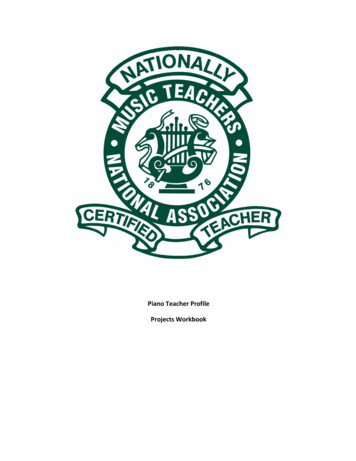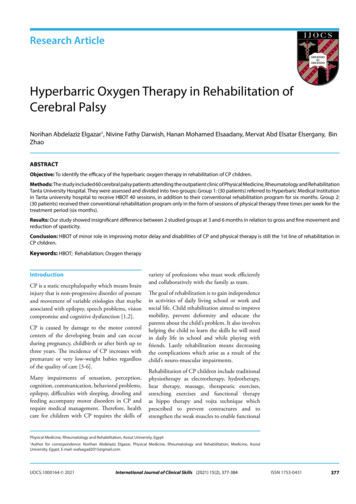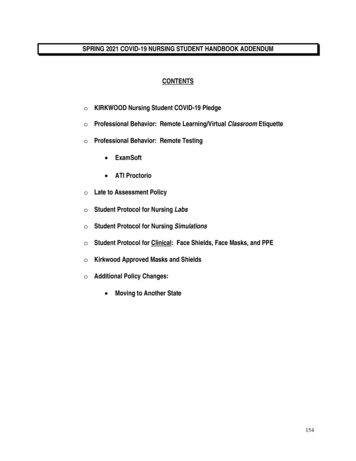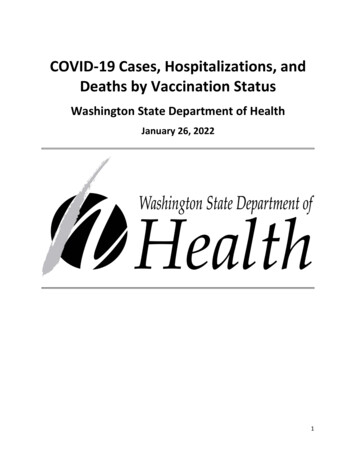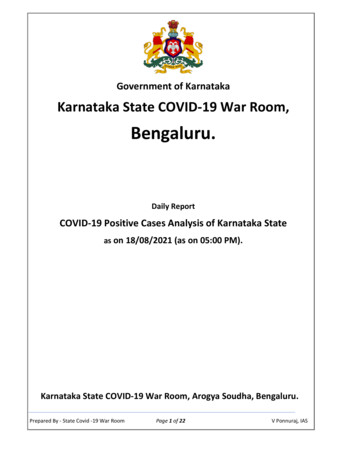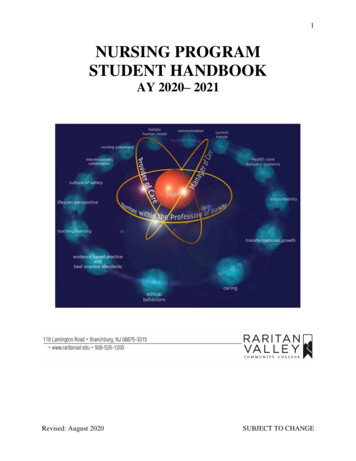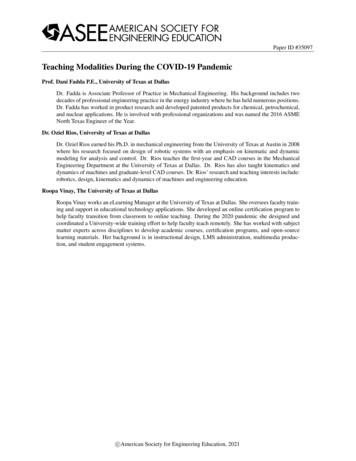
Transcription
Paper ID #35097Teaching Modalities During the COVID-19 PandemicProf. Dani Fadda P.E., University of Texas at DallasDr. Fadda is Associate Professor of Practice in Mechanical Engineering. His background includes twodecades of professional engineering practice in the energy industry where he has held numerous positions.Dr. Fadda has worked in product research and developed patented products for chemical, petrochemical,and nuclear applications. He is involved with professional organizations and was named the 2016 ASMENorth Texas Engineer of the Year.Dr. Oziel Rios, University of Texas at DallasDr. Oziel Rios earned his Ph.D. in mechanical engineering from the University of Texas at Austin in 2008where his research focused on design of robotic systems with an emphasis on kinematic and dynamicmodeling for analysis and control. Dr. Rios teaches the first-year and CAD courses in the MechanicalEngineering Department at the University of Texas at Dallas. Dr. Rios has also taught kinematics anddynamics of machines and graduate-level CAD courses. Dr. Rios’ research and teaching interests include:robotics, design, kinematics and dynamics of machines and engineering education.Roopa Vinay, The University of Texas at DallasRoopa Vinay works an eLearning Manager at the University of Texas at Dallas. She oversees faculty training and support in educational technology applications. She developed an online certification program tohelp faculty transition from classroom to online teaching. During the 2020 pandemic she designed andcoordinated a University-wide training effort to help faculty teach remotely. She has worked with subjectmatter experts across disciplines to develop academic courses, certification programs, and open-sourcelearning materials. Her background is in instructional design, LMS administration, multimedia production, and student engagement systems.c American Society for Engineering Education, 2021
1Session XXXXTeaching Modalities During the COVID-19 PandemicDani Fadda and Oziel RiosMechanical Engineering DepartmentThe University of Texas at DallasRoopa VinayEducational Technology ServicesThe University of Texas at DallasAbstractTeaching during the COVID-19 pandemic demands social distancing with personal protectionequipment for in-person classes or web enabled cameras for virtual classes. Five different teachingmodalities are used at our university during the pandemic. The modalities are presented in this paperalong with the choices made by the engineering and computer science faculty. The majority of theengineering and computer science faculty are found to prefer teaching virtually in a ‘Remote Virtual’synchronous modality since this is the closest to in-person teaching. The ‘Online’ asynchronousmodality is the second most-preferred option during the pandemic and requires the development oflearning modules with video recordings. More faculty are teaching remotely in the Spring of 2021 ascompared to the Fall of 2020 because many of their students are viewing the course materials fromhome instead of coming to the classroom and dealing with personal protective equipment withcontinued concerns of spreading the virus. Additional work is ongoing to assess the efficacy of theteaching modalities in individual courses and will be subject of future publications.IntroductionMost engineering and computer science faculty members at our public university prefer teaching in aface-to-face format in the classroom instead of teaching virtually. However, during the COVID-19pandemic, the faculty are asked to choose among five teaching modalities that cope with the pandemic.The teaching modalities offered by the university are ‘Traditional Classroom/Laboratory,’ ‘BlendedHybrid,’ ‘Flexible mode,’ ‘Remote Virtual,’ and ‘Online.’It is important to note that a complete learning management system [1] is widely implemented acrossthe university. This system includes capable video conferencing and online collaborating tools thatcan support the offered modalities. This system is also upgraded to offer automated and liveAmericans with Disabilities Act (ADA) compliant subtitles of the lectures and the discussions in theclass [2]. The team operating the learning management system also offers online teaching certificationand support to the faculty for developing online classes [3, 4].The engineering and computer science faculty are given a choice among these modalities that best suittheir courses. All modalities include video recordings of the class work to allow asynchronous viewingProceedings of the 2021 ASEE Gulf-Southwest Annual ConferenceBaylor University, Waco, TXCopyright 2021, American Society for Engineering Education
2with ADA compliant subtitles and transcripts. This is available to all students but essential for thosewho are less tolerant of the risk of contracting the coronavirus. A description of each modality ispresented. The choices by the faculty are also presented in two subsequent semesters.Description of the ModalitiesThe Traditional, the Blended Hybrid, and the Flexible modalities include face-to-face instruction withsocial distancing and personal protective equipment. The Traditional and Blended Hybrid modalitiesutilize classrooms where social distancing measures can be implemented. The Flexible modalityallows a small number of alternating students to be physically present in the classroom while othersattend synchronously online. These three modalities (Traditional, Blended Hybrid, and Flexible) allowthe faculty to continue teaching their classes in a classroom, using classroom equipment as theynormally do. However, the student’s physical attendance in the classroom is not mandatory throughoutthe duration of the pandemic. For that reason, cameras are installed in the classrooms to allow studentswho cannot be physically present in the classroom to attend the class remotely and synchronously orat a later time.The Remote Virtual and Online modalities are performed online synchronously and asynchronously,respectively. They exclude any face-to-face contact. However, the two modalities are inherentlydifferent. The Remote Virtual modality requires the faculty’s presence online during the class’ hourwhile students who can attend synchronously are encouraged to do so. Others are allowed to watchthe recording at a later time with no penalty. The faculty conducts the class in a very similar manneras they previously did in the classroom. The resulting Remote Virtual video recordings are posted inthe learning management system according to the dates when they were delivered. The MicrosoftTeams software is used for this Remote Virtual modality as the videoconferencing tool. Using Teams,the professor can see the students and the students can raise their hand and ask questions or makecomments during the session by voice or by text.The Online modality requires pre-recording lecture materials and streaming them, on demand, throughthe learning management system. Instead of delivering a complete lecture in one video at a scheduledhour, learning modules are typically created to host a multitude of short video recordings, eachcovering a specific area of a complete lecture. The short Online video recordings can be organizedwithin a learning module to assist the students as they navigate through the course [3, 4].Discussion boards can be used in all modalities but they are especially important in the Onlinemodality for students to post questions and comments anytime. Other students, teaching assistants, orthe professor can answer the questions and address the comments. A high level of activity in thediscussion board gives an indication of interest in the course materials and helps the class to developa sense of community as described by Ray and Tabas [5].Office hours, for all modalities can be offered using Teams teleconferencing or simply by using thephone. However, the students seem to prefer communicating and getting answers by email in lieu ofoffice hours.Proceedings of the 2021 ASEE Gulf-Southwest Annual ConferenceBaylor University, Waco, TXCopyright 2021, American Society for Engineering Education
3Modality Selections by FacultyThe modalities implemented in the university’s engineering and computer science school during theFall semester of 2020 and the Spring semester of 2021 are shown in the university’s public informationsystem for each class [6]. The data is downloaded and the number of faculty members teaching ineach of the different modalities are counted. The total number of faculty members teaching classes is270 per semester (average for Fall 2020 and Spring of 2021) in the school of engineering and computerscience. The modality selected by each of these faculty members are shown in Fig. 1, which is a plotof the percentage of faculty members teaching in each of the five different modalities. Severalconclusions are drawn based on this data as described below.Figure 1. Teaching modalities selected by the engineering and computer science facultyduring the Fall of 2020 and the Spring of 2021The first and most obvious observation is that the majority of faculty prefer the Remote Virtual or theOnline modalities during the pandemic. These two modalities correspond to no face-to-face contactamong any of the people involved with the class. This observation indicates that the majority of theengineering and computer science faculty are highly concerned about the contagious nature of thevirus. Their concern is legitimate according to the findings of Leidner et al. [7]. While several studentsat the university and the neighboring areas tested positive for COVID-19 during the pandemic, therewas no spread within the school due to this preference.Another observation is made in the split between the two virtual modalities. Specifically, about threetimes more faculty prefer the Remote Virtual (synchronous) modality than those who prefer the Online(asynchronous) modality. The reason is that the Remote Virtual classes are offered in a manner similarto that used in the classroom. The transition from the classroom to the Remote Virtual environmentrequires a pad, an overhead camera, or a white board in the view of the camera to replace the whiteboard in the classroom. This modality is significantly more effective for delivering the completeProceedings of the 2021 ASEE Gulf-Southwest Annual ConferenceBaylor University, Waco, TXCopyright 2021, American Society for Engineering Education
4coursework without the need to pre-prepare online videos and online learning modules that aretypically used within a course which is offered in an Online modality.The least popular modality shown in Fig. 1 is the Flexible Mode. This is not, by any means, a negativeindication of the effectiveness of this modality. However, this modality is not preferred by our facultyat this time, because it falls with others that require in-person teaching during the pandemic. Moreover,it adds burden on the faculty for splitting the students into groups that take turns between physicallyattending class and virtually watching the recording when only a few students chose to attend the classphysically.When comparing the data for the Fall semester of 2020 to the Spring semester of 2021 in Fig. 1, thereis a reduction in the percentage of faculty members in the school of engineering and computer scienceteaching in all of the modalities that require in-person teaching (Traditional Classroom/Laboratory,Blended Hybrid, and Flexible Mode) and a corresponding increase in the virtual teaching (RemoteVirtual and Online). This is because only a few students came to class, leaving the professor teachingwith personal protective equipment to a large room with only a few students who are spaced apart andrequired to wear personal protective equipment while others watched the posting video recordings ofthe lectures at home. Specifically, even though most students desire to experience and enjoy thecampus life, only a few students took the risk to be on campus during the pandemic.A survey is deployed to the faculty, requesting reasons for their choice. Seventy-eight (78) responsesare obtained between January 28 and February 8, 2021 where some offer detailed answers. One facultymember who chose the in-person modality wrote: “Since it is well known that more than 50% ofcommunication is nonverbal communication, I think a lot of teaching quality is lost through onlineteaching.” Furthermore, faculty members who chose to teach in the Remote Virtual modalityexpressed that they wanted to have ‘live’ contact with students and relayed that the remote virtualmodality offers “more effective interactions with students.” Other faculty members wrote thatteaching in the Online Modality allows busy students, or those in other time zones, to watch lectureswhen best for them and allows the professor to edit and perfect the lectures without having to worryabout technical connection issues as those do in the Remote Virtual modality.The responses in the survey also addressed the shift from one modality to another. One faculty memberwrote: “Last semester, the course was Remote/Virtual with live lectures every week. Since studentscan take the course asynchronously anytime, only half or even less attended the live lectures andparticipated in the lectures. But the course is not designed as an online course and it hinders thestudents' learning who take it asynchronously. This semester, I designed this course by followingonline course recommendations from engineering education perspectives. Hopefully, all students willbenefit from it.”ConclusionsFaculty members in the school of engineering and computer science at our university are given theauthority to choose among five different modalities to deliver their classes. The majority chose to usecameras and teaching virtually over using other teaching modalities that can potentially spread theProceedings of the 2021 ASEE Gulf-Southwest Annual ConferenceBaylor University, Waco, TXCopyright 2021, American Society for Engineering Education
5virus. Among the two virtual modalities, the “Remote Virtual” synchronous modality is the highestused modality because of its similarity to teaching in a classroom. The “Online” asynchronousmodality is the next most popular. More faculty will teach virtually in the Spring of 2021 than in theFall of 2020, even though they desire to teach in-person, mainly because most students are avoidingthe campus. The faculty’s assessment of the student’s work and the student’s course evaluations arecourse-specific. They will be subject of future papers.References1. Blackboard eLearning: https://www.blackboard.com/2. Microsoft Stream: osoft-stream3. Fadda, D. and Rios, O., 2019, “Online Computer Aided Design Class,” 126th ASEE AnnualConference and Exposition, June 15 - 19, 2019, Tampa, Florida, USA4. Fadda, D. and Vinay, R., 2019, “Teaching Computer Aided Design Online,” Proceedings of theASEE Gulf-Southwest Annual Conference, The University of Texas at Tyler, March 10-12,Tyler, Texas, USA.5. V. M. Ray and J. Tabas, "Developing Improved Methodology for Online Delivery ofCoursework Providing a Framework for Quality Online Education," in Proceedings of the ASEEAnnual Conference and Exposition, Salt Lake City, Utah, 2018.6. CourseBook at the University of Texas at Dallas: https://coursebook.utdallas.edu/7. AJ Leidner, V Barry, VB Bowen, et al., Opening of Large Institutions of Higher Education andCounty-Level COVID-19 Incidence — United States, July 6–September 17, 2020. MMWRMorb Mortal Wkly Rep2021;70:14–19. DOI: http://dx.doi.org/10.15585/mmwr.mm7001a4DANI FADDADr. Fadda is Associate Professor of Practice in Mechanical Engineering. His background includes two decades ofengineering practice in the energy industry where he has held numerous positions. Dr. Fadda has worked in productresearch and developed patented products for chemical, petrochemical, and nuclear applications. He is an ASME Fellowand a Professional Engineer.OZIEL RIOSDr. Oziel Rios earned his Ph.D. in mechanical engineering from the University of Texas at Austin in 2008 where hisresearch focused on design of robotic systems with an emphasis on kinematic and dynamic modeling for analysis andcontrol. Dr. Rios teaches the first-year and CAD courses in the Mechanical Engineering Department at the University ofTexas at Dallas. Dr. Rios has also taught kinematics and dynamics of machines and graduate-level CAD courses. Dr. Rios’research and teaching interests include: robotics, design, kinematics and dynamics of machines and engineering education.ROOPA VINAYMs. Roopa Vinay is an eLearning Manager at the University of Texas at Dallas. She oversees faculty training and supportin educational technology applications. She developed an online certification program to help faculty transition fromclassroom to online teaching. She has worked with subject matter experts across disciplines to develop a wide range ofacademic courses, certification programs, and open-source learning materials. Her background is in instructional design,LMS administration, multimedia production, and student engagement systems.Proceedings of the 2021 ASEE Gulf-Southwest Annual ConferenceBaylor University, Waco, TXCopyright 2021, American Society for Engineering Education
The Remote Virtual and Online modalities are performed online synchronously and asynchronously, respectively. They exclude any face-to-face contact. However, the two modalities are inherently different. Th
